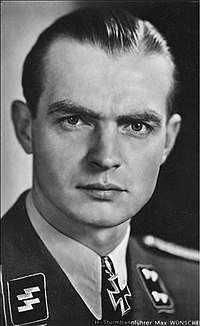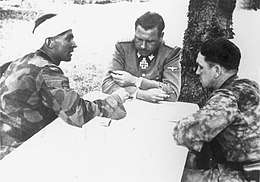Max Wünsche
Max Wünsche (20 April 1914 – 17 April 1995) was a member of the SS of Nazi Germany and a regimental commander in the Waffen-SS during World War II. He was a recipient of the Knight's Cross of the Iron Cross with Oak Leaves.[2]
Max Wünsche | |
|---|---|
 | |
| Born | 20 April 1914 Kittlitz (Löbau)de, German Empire |
| Died | 17 April 1995 (aged 80) Munich, Germany |
| Buried | |
| Allegiance | |
| Service/ | |
| Years of service | 1933–44 |
| Rank | Obersturmbannführer |
| Service number | NSDAP #5,508,247 SS #153,508[1] |
| Unit | SS Division Leibstandarte Führerbegleitkommando SS Division Hitlerjugend |
| Battles/wars | World War II |
| Awards | Knight's Cross of the Iron Cross with Oak Leaves |
Biography
Max Wünsche was born on 20 April 1914 in Kittlitz. In July 1933 Wünsche joined the SS. In 1935, he graduated from SS-Junkerschule at Bad Tölz and was promoted to Untersturmführer.[2] Wünsche was then posted to the Leibstandarte SS Adolf Hitler (LSSAH) as a platoon leader.[2] In October 1938, Wünsche was assigned as an orderly officer for Hitler. In that role, Wünsche joined the Führerbegleitkommando (the SS bodyguard unit), which provided personal security for Hitler.[3]
In January 1940 he was again posted to the LSSAH, as a platoon commander in a motorcycle company under the command of Kurt Meyer, for the invasion of the Netherlands and the Battle of France. In December 1940 he became an adjutant to Sepp Dietrich during the invasion of the Balkans (Operation Marita) and the invasion of the Soviet Union (Operation Barbarossa). In February 1942 Wünsche was given the command of the LSSAH Sturmgeschütz (assault gun) battalion.[2]
In 1942 Wünsche completed the General Staff training course at the Staff College in Germany and was promoted to Sturmbannführer. In September 1942 he was posted to the LSSAH and resumed command of the Sturmgeschütz battalion; in October he assumed command of a battalion in a panzer regiment of LSSAH. His battalion's first action was at Kharkov in 1943. On 25 February 1943 Wünsche's battalion went into action against a defensive position manned by the Soviet 350th Rifle Division. Supported by artillery and a company of SS grenadiers, Wünsche's battalion attacked and overran the Soviet front lines.[2] Wünsche's assault would lead to the destruction of 47 artillery pieces and anti-tank guns.[2] For his actions during the battles for Kharkov, Wünsche was awarded the German Cross in Gold and later the Knight's Cross, both in February 1943.[2]
In June 1943, Wünsche was transferred to a new division forming in France, 12th SS Panzer Division Hitlerjugend, to take command of the 12th SS Panzer Regiment. On 6 June 1944, the Allies landed in Normandy (Operation Overlord) and the division was committed to action on 7 June. The division was later trapped in the Falaise pocket, where on the night of 20 August, Wünsche escaped on foot. He was wounded and taken prisoner by British soldiers.[2]
Wünsche spent the rest of the war as a prisoner of war in camp 165 at Caithness, Scotland, a special camp for high-ranking German officers.[4] In 1948 Wünsche was released and returned to Germany.[4] He died in 1995.[2]
Summary of SS career

- Decorations
- Iron Cross (1939) 2nd Class (25 May 1940 & 1st Class (31 May 1940)[5]
- German Cross in Gold on 25 February 1943 as SS-Sturmbannführer in the I./SS-Panzer-Regiment 1[6]
- Knight's Cross of the Iron Cross with Oak Leaves
References
Citations
- Westemeier 2013, p. 664.
- Nipe & Spezzano 2002, p. 129.
- Hoffmann 2000, p. 55.
- Gordon, Barry (18 December 2007). "scotsman". The Scotsman. Edinburgh.
- Thomas 1998, p. 461.
- Patzwall & Scherzer 2001, p. 525.
- Scherzer 2007, p. 799.
Bibliography
- Hoffmann, Peter (2000) [1979]. Hitler's Personal Security: Protecting the Führer 1921-1945. New York: Da Capo Press. ISBN 978-0-30680-947-7.CS1 maint: ref=harv (link)
- Nipe, George; Spezzano, Remy (2002). Platz Der Leibstandarte The SS Panzer Grenadier Division "LSSAH" and the Battle of Kharkov January–March 1943. Southbury, CT: RZM Imports. ISBN 978-0-9657584-2-0.CS1 maint: ref=harv (link)
- Patzwall, Klaus D.; Scherzer, Veit (2001). Das Deutsche Kreuz 1941 – 1945 Geschichte und Inhaber Band II [The German Cross 1941 – 1945 History and Recipients Volume 2] (in German). Norderstedt, Germany: Verlag Klaus D. Patzwall. ISBN 978-3-931533-45-8.CS1 maint: ref=harv (link)
- Scherzer, Veit (2007). Die Ritterkreuzträger 1939–1945 Die Inhaber des Ritterkreuzes des Eisernen Kreuzes 1939 von Heer, Luftwaffe, Kriegsmarine, Waffen-SS, Volkssturm sowie mit Deutschland verbündeter Streitkräfte nach den Unterlagen des Bundesarchives [The Knight's Cross Bearers 1939–1945 The Holders of the Knight's Cross of the Iron Cross 1939 by Army, Air Force, Navy, Waffen-SS, Volkssturm and Allied Forces with Germany According to the Documents of the Federal Archives] (in German). Jena, Germany: Scherzers Militaer-Verlag. ISBN 978-3-938845-17-2.CS1 maint: ref=harv (link)
- Thomas, Franz (1998). Die Eichenlaubträger 1939–1945 Band 2: L–Z [The Oak Leaves Bearers 1939–1945 Volume 2: L–Z] (in German). Osnabrück, Germany: Biblio-Verlag. ISBN 978-3-7648-2300-9.CS1 maint: ref=harv (link)
- Westemeier, Jens (2013). Himmlers Krieger: Joachim Peiper und die Waffen-SS in Krieg und Nachkriegszeit [Himmler's Warriors: Joachim Peiper and the Waffen-SS during the War and Post-War Period]. Paderborn, Germany: Ferdinand Schöningh. ISBN 978-3-506-77241-1.CS1 maint: ref=harv (link)